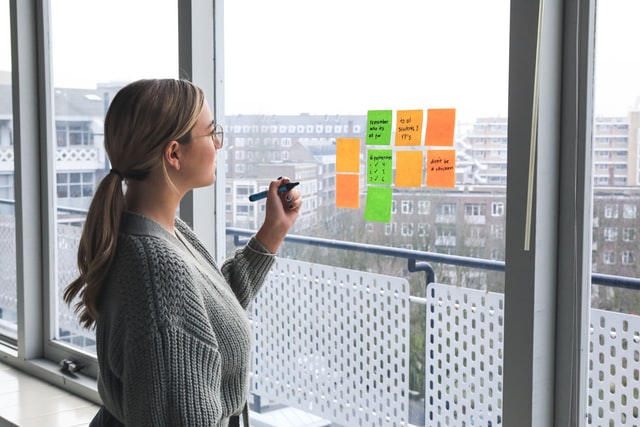Virtual Presentations: Making Eye Contact is Key

Zoom in, Zoom out.
But never lose your focus.
Shikha Td, poet
There are many reasons you will need to know how to speak to a camera.
- You are in an online class and you have to record your speech to submit it.
- You are making a conference presentation and the conference is online.
- You are in a Zoom/Teams (or other online) meeting.
- You are making a career presentation as part of a job interview.
- You are a teacher/trainer doing remote training.
- You are a businessperson making pitches online.
Let’s face it, the pandemic elevated the need for video meetings and presentations, and it is likely they are here to stay. Many businesses are doing interviews remotely and several have moved to online platforms for training. This chapter will talk about best practices for using a camera in a live online format and in a recorded and then playback format.
Understand the Context
The first thing you need to do is fully understand the context. Will you be recording and uploading, or will you present live? Is this a one-time presentation? Will this presentation be recorded so others can see it online? All these factors will make a difference.
Check Your Light
Make sure you have adequate lighting.
- Never be in front of a window where you are backlit.
- Always have adequate lighting on your face.
- Use a lamp or lighting system to light your face and adjust it properly.
- If you use a ring light, try bouncing it off the ceiling so you do not get light rings in your pupils.
- Avoid using an overhead light because it casts shadows under your eyes.
Check your Camera
I once made a 30-minute video recording of a lecture to realize later that I didn’t have the equipment set up correctly. The sound was not recorded. I was so frustrated because I had to do the entire thing over again. Avoid my mistake and record a test segment and then make sure it works before you record too much of your speech. Look at the playback and consider whether the lighting is good enough for the audience to see your face.
If you have an important conference on Zoom or Teams, check your equipment beforehand. The first time I taught online, I practiced with my family. I practiced making the slides work, checking the microphone, the lighting, and the camera angle. Most accounts will allow you to sign up for a temporary free account if you need to practice outside of school or work.
Check the Sound
Record yourself speaking for a minute and then play it back. Is the sound OK? Can the audience hear you clearly? If not, adjust your microphone. Sometimes the sound echoes in the room or there are too many background noises. Make sure your audio is clear and there is very little interference.
Some setups work better using a headset and microphone and some computers and cell phones work well with the main microphone. In many programs, you can go in through settings and adjust to the sound.
Check for Interferences
I had a student give his speech using his computer and he set his phone on the desk beside his laptop. He kept getting audio notifications beeping throughout his speech. It was very distracting. Turn off notifications or turn off your cell phone entirely. If you are working from home, tell your roommates, siblings, and friends you will need the space to be quiet. Closing the window and closing the door can help keep out some ambient sound.
Put the Video Camera at or Above Eye Level
This may mean you set your laptop on a stack of books, or you readjust your web camera on your desktop. However it is accomplished, make sure the camera is level or a little higher than your eyes. The most common mistake that I see is when someone leans the laptop lid back making it look like the camera is looking up the nose of the speaker.
Look Directly into the Camera
Eye contact is established when you look at the camera directly. If it helps, draw a smiley face and put it on your camera to remind you to look in the “eyes” of your audience.

Think About Where to Put the Note Cards
Tape your note cards to the top of your computer screen or hang them on something behind your computer. Place your cards so you never have to look down to see your notes.
Frame the Shot
Depending on the type of speech, you want to frame your head or do a 3/4 shot. It is best to frame the shot so the audience can see your gestures.
Head Shot
Notice how public speaking guru uses a close up shot, allowing us to see his gestures while making strong eye contact.
Watch Virtual Communication | Mark Bowden on YouTube (7 mins)
Video source: Speakers Spotlight. (2020, March 19). Virtual communication | Mark Bowden [Video]. YouTube. https://youtu.be/mg0ahpQxQ4A
Stand Don’t Sit (If possible)
You should read the situation on this one, but if in doubt stand. You will have better air support if you are standing. You will also gesture more freely.
Gesture
You should have open gestures. If you do a tight headshot, you will not see your gestures, so you need to pull the camera back and gesture higher.
Fix the Camera Zoom in One Place
If you are having a friend record you with a handheld device, make sure that the zoom is kept in one place. Sometimes bored camera operators will zoom in and out making for a very unprofessional recording.
Plan the Ending
Your ending will leave a lasting impression so do not leave it to chance. Plan out the exact last words and then resist the temptation to tack on any last comments. Speech endings are always challenging, they are even more difficult online.
Edit the Video
If you are recording your video in advance to be played back later. Edit the part where your arm reaches up to turn on and turn off your recording device. If appropriate, use the feature that allows you to put words on the screen if important words or concepts are relevant.
Here is a video I found helpful (mostly) about lighting setup and camera placement. I particularly like her advice to wear pants.
Watch How To Look Better On Video Calls/FaceTime/Zoom on YouTube (10 mins)
Video source: How Do You Do? (2020, August 23). How to look better on video calls/FaceTime/Zoom [Video]. YouTube. https://youtu.be/7ppTAA-1tm0
During the 2020 pandemic when many things went viral, Toastmasters held its speech contests virally. Notice how this creative speaker made the most of the situation to earn him the first-place win.
Watch 2020 Toastmasters World Champion of Public Speaking: Mike Carr on YouTube (8 mins)
Video source: Toastmasters International. (2020, August 31). 2020 Toastmasters World Champion of public speaking: Mike Carr [Video]. YouTube. https://youtu.be/TA7awoBxBxc
Key Takeaways
Remember This!
- Always check your equipment: Camera, microphone, lighting.
- Make “eye contact” by looking into your camera.
- Adjust your camera so it is eye level or slightly above eye level
Attribution
Except where otherwise noted, this chapter is adapted from “Speaking to a Camera: Making Eye Contact is Key” In Advanced Public Speaking by Lynn Meade, licensed under CC BY 4.0.

